White to play and win in all three positions:
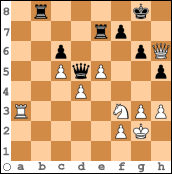
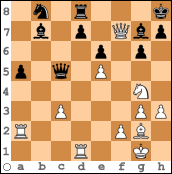
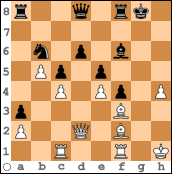
I have promised to write a bit about how it can be that a player can be close to 2650 and still “not be able to calculate”.
To most this sounds almost obscene, of course. I understand this, but if we agree on what this means, brick by brick, I will be able to illustrate it quite easily. In the process I will also take the chance to refer to my article in New in Chess Magazine, volume 6, out a few weeks ago. This article explains a central idea from the forthcoming Thinking inside the Box (which I am starting to feel brave enough to write).
First off. 2650 is not just good; it is a great level to be at. Especially if you are reasonably young. But we should not remember that it is still not in the top 100 and more than 200 points below Magnus Carlsen – equalling an expected score below 25%. And I am sure no one would call the World Champion infallible, no matter how scary he has been over the last few years.
So 2650 is great, but Mr. X is still very much human.
Next definition is the four different types of decisions (See Grandmaster Preparation – Strategic Play for more on this; or in Box when it comes):
1. Automatic decisions (forced moves; and most of all preparation)
2. Easy decisions (generally intuitive for most people; but Grandmaster Preparation – Positional Play shows a system by which you can think about these things for those of us who have a more logical approach).
3. Critical Moments (positions where you would anticipate that one move is clearly better than all others)
4. Strategic Positions (a] long term decisions that might appear anti-positional at first. b] a mixture of 2 & 3, as neither will be able to solve the problem alone).
Mr. X has excellent opening preparation and gets really good positions. He also has a fantastic feeling for chess; when I gave him simple positions where there was no tactical angle, he usually got it right within seconds (though no one is flawless). With strategic positions he was able to see the right ideas quite easily and the tactical aspects sort of “just happened”.
This leaves us with 3. Critical Moments.
The training session took place over five days. For the first two days, I was feeling my way, observing him, seeing how he performed in various exercises, as well as just establish rapport. Although he is doing all the hard work, I still find it draining. I have to leave him be when he thinks, and at the same time guess what he is thinking.
I asked him to look through the last three tournaments to find mistakes of more than +1. From these 24 games (where some of the players were 2200s), he found ten (10!) games where he had missed something big. Most of the times a direct win or a big tactic.
On the third day I felt confident enough to make the simple statement:
“Your calculation is rubbish.”
He did not fully accept this until he had a look at his games. His demeanour changed quite a lot. Obviously he had enough respect for me to visit and pay me for my time, but as he is a better player than I ever was, he had probably not expected that I would really be able to teach him something new. Actually he said that he had had training sessions with former 2700-players (still paying), where he had not learned anything new, only refined what he already knew.
So what was the main thing he learned? That calculation is finding what you do not see automatically. A longer explanation can be found in the NIC article already mentioned. An even better (hopefully) and more elaborate explanation will be found in Box, when I get around to writing it.
Here is a typical example:
Khismatullin – Savchenko, Khanty-Mansiysk 2013
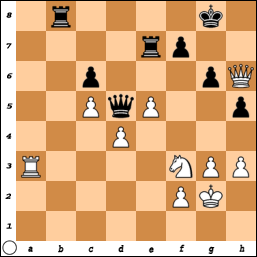
Like the white player (rated 2674), Mr X thought 53.g4 was worth a try. Black equalised in the game with 53…hxg4 54.hxg4 Reb7!.
Instead White wins immediately with 53.Kh2!. A simple move, but possible to miss.
I also showed him the positions from my NIC article, which he had not yet seen. For those who want to compare, I can say that he missed …Bd2 and failed to solve 1-2 of the other positions as well.
Most telling was this position:
Manakova – Warakomski, Erice 2014
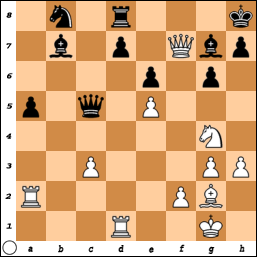
Mr X thought for five minutes and came with a move. I honestly cannot remember which. I asked him what else he had looked at. He gave two other nonsensical ideas. I asked for more ideas. He got a bit flustered, but started looking, really looking. He found another idea. And another idea. Only around his 9th suggestion delivered what I had asked for: an idea where everything fell into place immediately. Eventually he came up with 29.Nh6!, which after 29…Rf8 30.Qg8+ caused resignation. Maybe this was his 12th idea!?
To sum up: Certainly Mr X saw a lot of tactical ideas and moves in any position. Many would even think that he calculated well if they did not know any better. But he was guided mainly be his amazing intuition. As you cannot use intuition to do statistics, it also does not work for calculation. There is a tendency for everyone to rely on their main tools. Truly great chess players know how to use different tools for different decisions.
Let us finish with a nice little candidate move exercise:
Caruana – Carlsen, St Louis 2014
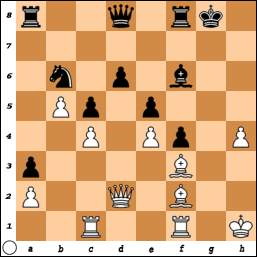
29.Rcd1? Kh8 30.Qxd6 Qxd6 31.Rxd6 Nxc4 32.Rd5 Ne3 33.Bxe3 fxe3 34.Be2 Bxh4 35.Rf5 Rxf5 36.exf5 Rd8 37.Rxd8+ Bxd8 38.Kg2 Kg7 39.Kf3 Kf6 40.Ke4 c4 41.Bxc4 Bb6 42.Bd3 ½-½
29.Rfd1! causes a collapse in the Black position. The c-pawn remains defended and after 29…Be7 White wins with 30.Bxc5! dxc5 31.Qg2+.
29…Bxh4 30.Rg1+ Kh8 31.Rg2! is also decisive.
Obviously the situation was exceptional, but from a calculation point of view there is not a big different between this and the other positions. Getting the idea is the main thing for someone like Mr X. The rest just “happens” to him in a fraction of a second (well, probably 3 seconds to be accurate – more about this another time).
Everything I had hoped for in this article. Thanks for being so awesome, Jacob. Cannot wait for your new book.
Also – just been thinking about this Jacob – how was he in the Endgames where they say precise calculation is needed? If he was weak, did he somehow steer the late middlegame towards more strategic endgame positions?
Missed 1.Kh2, saw 1.Nh6 Bxe5 (1…Rf8 2.Qg8+ mating) 2.Bxb7 Rf8 3.Rxa5 within 3-5 minutes and I cheated by watching FM Maurice Ashley’s live commentary on the last puzzle. 🙂
GM, not FM. Typo.
@Michael Bartlett
It was not really that relevant, but there were issues there as well. In general, you can get to 2650 with just a few strengths and a lot of experience and raw talent. Mr X is very strong and could be a future star for all I care. But he needs a deeper understanding of the game.
Your article in NiC is phantastic and well worth the price of the magazine alone (as usual there’s plenty of other interesting stuff in the magazine though). I often had the impression that I miss a lot by calculating too fast. But as a time trouble addict I was reluctant to force myself to calculate slower. Now I understood that I have to.
I saw 1.Kh2 (“1.Ng5 would be fantastic if it wasn’t for the fact that it’s illegal…”) and 1.Nh6 (“threatens a smothered mate, stops Black’s threat and Black can’t take it. Time to calculate a bit deeper…”). And like Seth I had seen the live broadcast of the Caruana – Carlsen game.
As a lowly 2100 player I find it very hard to grasp how one can be so strong yet take so much prodding to even consider 1.Nh6 in the second position since it makes such an obvious and crude threat which also has the virtue of preventing Black’s threat of 1… Rf8.
However, I could understand rejecting it due to 1… Bxe5 when 2.Bxb7 seems to allow the trapping of the queen by 2… Rf8 not seeing 3.Rxa5! exploiting that the rook on f8 is now insufficiently defended.
@Kasper Henriksen
Having about the same raing as you, I totally agree with you, Kasper. The 2 above positions you mentioned weren’t too hard to crack. I wonder how strong the 2650 player could get with an increased focus on calculation.
I believe the answer to that question would be, “Scary good.”
Jacob, could you list the exact title and publication date of the New in Chess article? I tried searching for it on their website but only found your article on Bent Larson. Thanks!
New in Chess Magazine, volume 6, right?